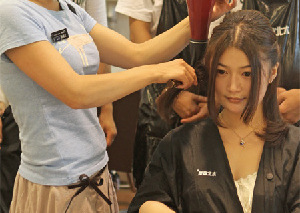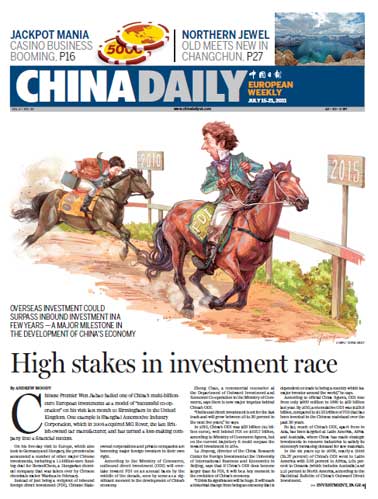Let there be smell
Updated: 2011-07-15 11:27
By Zhang Zixuan (China Daily)
The China Pavilion of Venice Biennale is wowing visitors with its unique approach to the theme, 'Illuminations'
|
|
As you walk into the white fog that pervades the Arsenale, Venice's 13th century cluster of armories, several clouds suddenly rise from the ground, emitting a strong smell of tea. This surreal scene is wowing visitors to the China Pavilion of the 2011 International Art Exhibition of the 54th Venice Biennale, Italy.
The theme of this year's biennale, dubbed the "Olympics of Arts", with a proud history of 116 years, is "Illuminations". The event, which began on June 4 and will run until Nov 27 at the Giardini and Arsenale venues, attracts participants from 89 counties and regions. While many of them use various demonstrations of light to tie in with the theme, China has taken a different approach.
"Light has a sacred symbolic significance in Western culture; but in Chinese philosophy, what is closest to it and has the same values is the idea of qi," Peng Feng, the curator of China Pavilion, whose theme is "Pervasion", says.
Qi, which literally translates as air, refers to the life force or energy flow of every creation in the universe, Peng explains. Western culture is direct - just like light - whereas Eastern culture is more amorphous, like qi.
Thus the theme "Pervasion", while a response to the theme "Illuminations", also distances itself from it, Peng explains.
Peng chose five traditional Chinese elements - incense, tea, Chinese herbal medicine, baijiu (white liquor) and lotus, each of which has a unique fragrance - to capture the philosophical context of qi, as reflected in traditional Chinese culture.
The grounds of China Pavilion are covered with thousands of pots, designed by artist Yang Maoyuan.
The Scented Air - by Yuan Gong, one of the five exhibited Chinese artists this year, offers the most dramatic visualization of the pervasion of qi.
Yuan uses a specially-made huge humidifier to generate water vapor that forms the white fog to fill the 6,000 cubic meters of China Pavilion.
"My work is a process art rather than an installation," Yuan says, pointing out that in about 30 minutes the fog can make everything disappear, before itself dissipating.
Yuan uses water to create the fog, adding incense to intensify its magical effect. Many in the audience found the effect quite incredible and insisted Yuan had used dry ice.
"Perhaps the most memorable work at this year's Chinese pavilion used the least material. Yuan Gong's dry-ice fog, periodically arising on the lawn and simultaneously filling the interior, recalls the misty space of traditional shan shui (mountain water) painting. But it also evokes the subtlety, pliability and, finally, enveloping pervasiveness with which Chinese culture has for millennia absorbed its would-be conquerors," Richard Vine, editor of international art review magazine Art In America comments in his review, China's New Normal in Venice.
Floating on the green area outside Arsenale is not just Yuan's fog, but several huge artificial clouds that are the handiwork of Chinese artist Cai Zhisong, and revolves around tea.
The clouds are actually cloud-shaped stainless steel containers filled with tea. As the natural breeze blows, tea-scented smoke wafts out of these containers through the holes.
"The shape of my clouds is quite like a traditional Chinese painting - the line drawing. The clouds have a propitious meaning and express Zen thoughts," Cai says.
The grounds of China Pavilion inside the Arsenale are covered with thousands of ceramic pots, of different sizes, filled with Chinese herbal medicine and carved on the inside with Chinese inscriptions.
They are the brainchild of artist Yang Maoyuan and the work is entitled All Things Are Visible. Visitors are free to take a pot home.
"Tomorrow my pots may appear on a windowsill in Latin America or anywhere in the world. This is the best way to communicate," Yang says.
Next to those pots is an installation by Liang Yuanwei, the only female Chinese artist this year. It uses a huge water pump filled, not with water but with baijiu, or Chinese white liquor, whose strong smell fills the pavilion.
"Liang Yuanwei's piece aptly fuses technology with absurdity," says Tom Jeffreys, art editor of Spoonfed.co.uk, a London-based website.
In Snow Melting in Lotus, by Pan Gongkai, dean of China Central Academy of Fine Arts, both sides of a temporarily built corridor are covered with Chinese ink lotuses, onto which an animation of falling snow is projected. Three air conditioners help keep the temperature of the corridor much cooler than the rest of the building.
"It is an attempt to create a poetic and vacant space that fits in with traditional Chinese culture," Pan says.
Peng, the curator of China Pavilion, who has earned wide applause this year, candidly admits that space limitations are what prompted the idea of "Pervasion".
"I hope the works pervade not just China Pavilion of the Venice Biennale, but also China and the rest of the world," he says.
E-paper

The perfect cut
Companies need to revamp, standardize to stave off quality challenges
Demystifying Tibet
Bubble worries
China calling
Specials

My China story
Foreign readers are invited to share your China stories.

90th anniversary of the CPC
The Party has been leading the country and people to prosperity.

Setting the pace in Turkey
China is building a 158-km high-speed railway in Turkey.

